Family Violence: Impact on Early Childhood Education and Care
VerifiedAdded on 2023/06/18
|15
|4438
|304
Report
AI Summary
This report examines the impact of family violence on children within early childhood learning environments. It evaluates Australian government initiatives and social policies related to family violence and child education, referencing statistical data and relevant government research. The report identifies current Australian and State Government departments involved in addressing family violence and promoting children's education. It analyzes resilience-raising strategies and approaches to support children, families, and communities affected by violence, and identifies relevant community organizations and external professionals. The report concludes by emphasizing the importance of addressing family violence to ensure effective children's care and education.
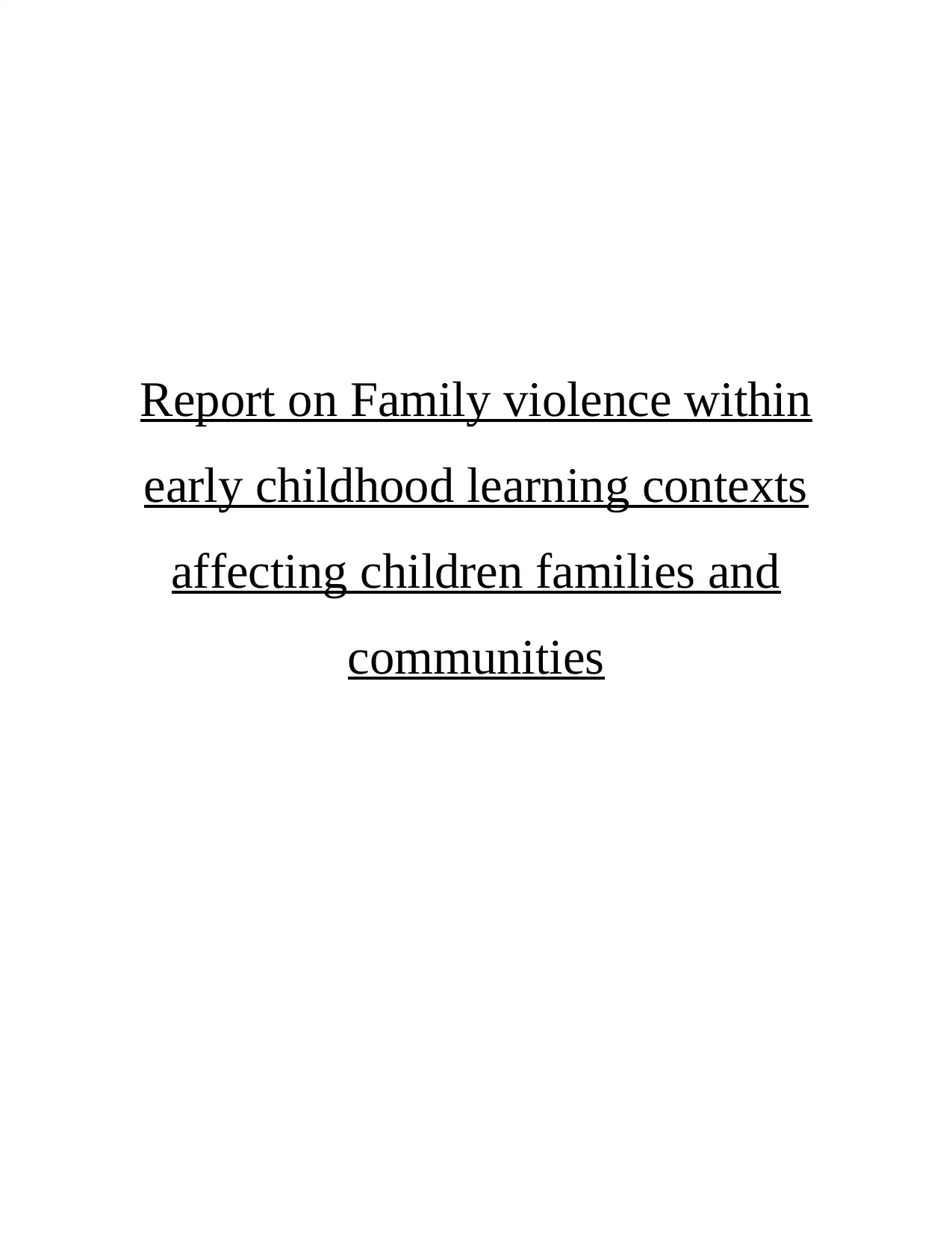
Report on Family violence within
early childhood learning contexts
affecting children families and
communities
early childhood learning contexts
affecting children families and
communities
Paraphrase This Document
Need a fresh take? Get an instant paraphrase of this document with our AI Paraphraser
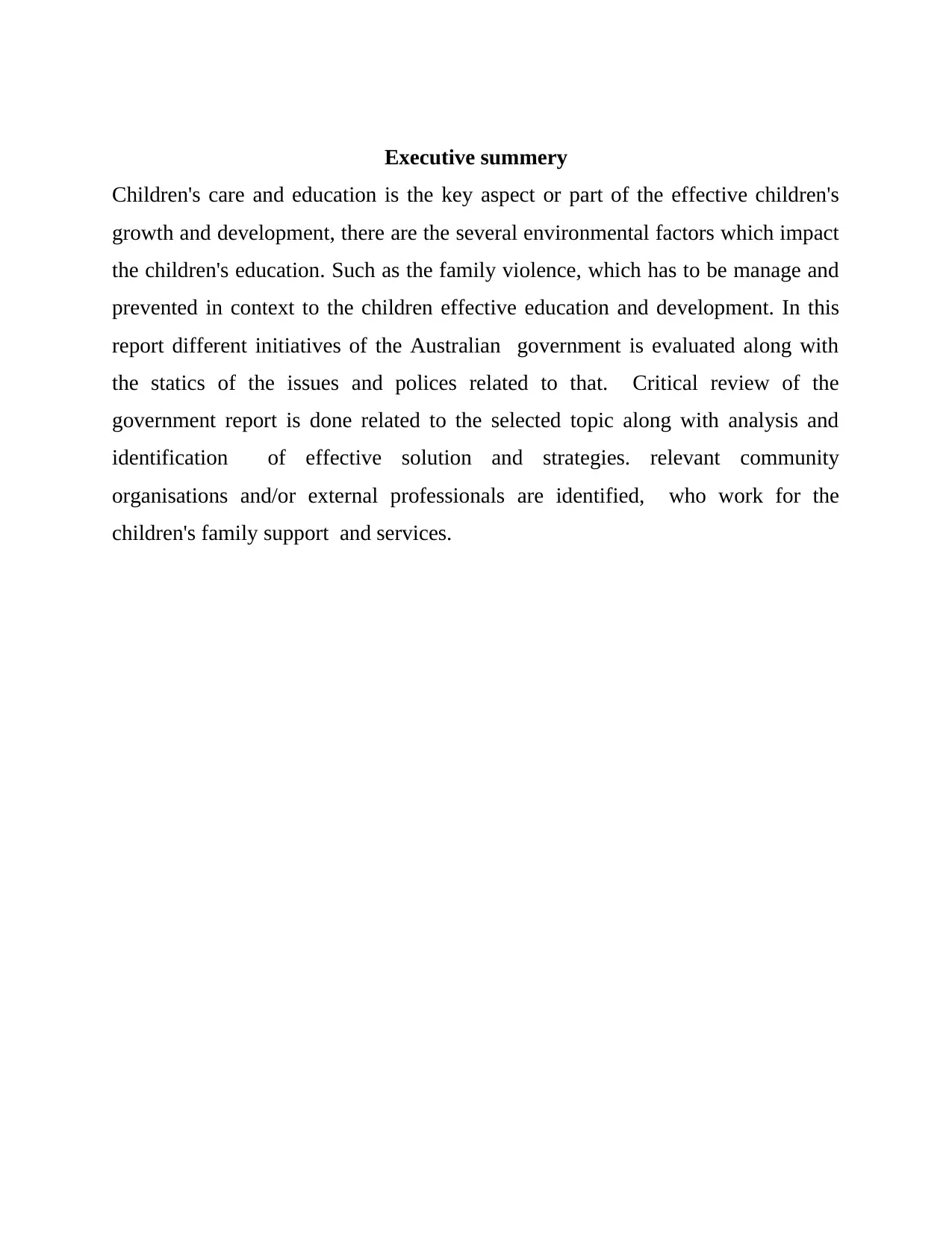
Executive summery
Children's care and education is the key aspect or part of the effective children's
growth and development, there are the several environmental factors which impact
the children's education. Such as the family violence, which has to be manage and
prevented in context to the children effective education and development. In this
report different initiatives of the Australian government is evaluated along with
the statics of the issues and polices related to that. Critical review of the
government report is done related to the selected topic along with analysis and
identification of effective solution and strategies. relevant community
organisations and/or external professionals are identified, who work for the
children's family support and services.
Children's care and education is the key aspect or part of the effective children's
growth and development, there are the several environmental factors which impact
the children's education. Such as the family violence, which has to be manage and
prevented in context to the children effective education and development. In this
report different initiatives of the Australian government is evaluated along with
the statics of the issues and polices related to that. Critical review of the
government report is done related to the selected topic along with analysis and
identification of effective solution and strategies. relevant community
organisations and/or external professionals are identified, who work for the
children's family support and services.
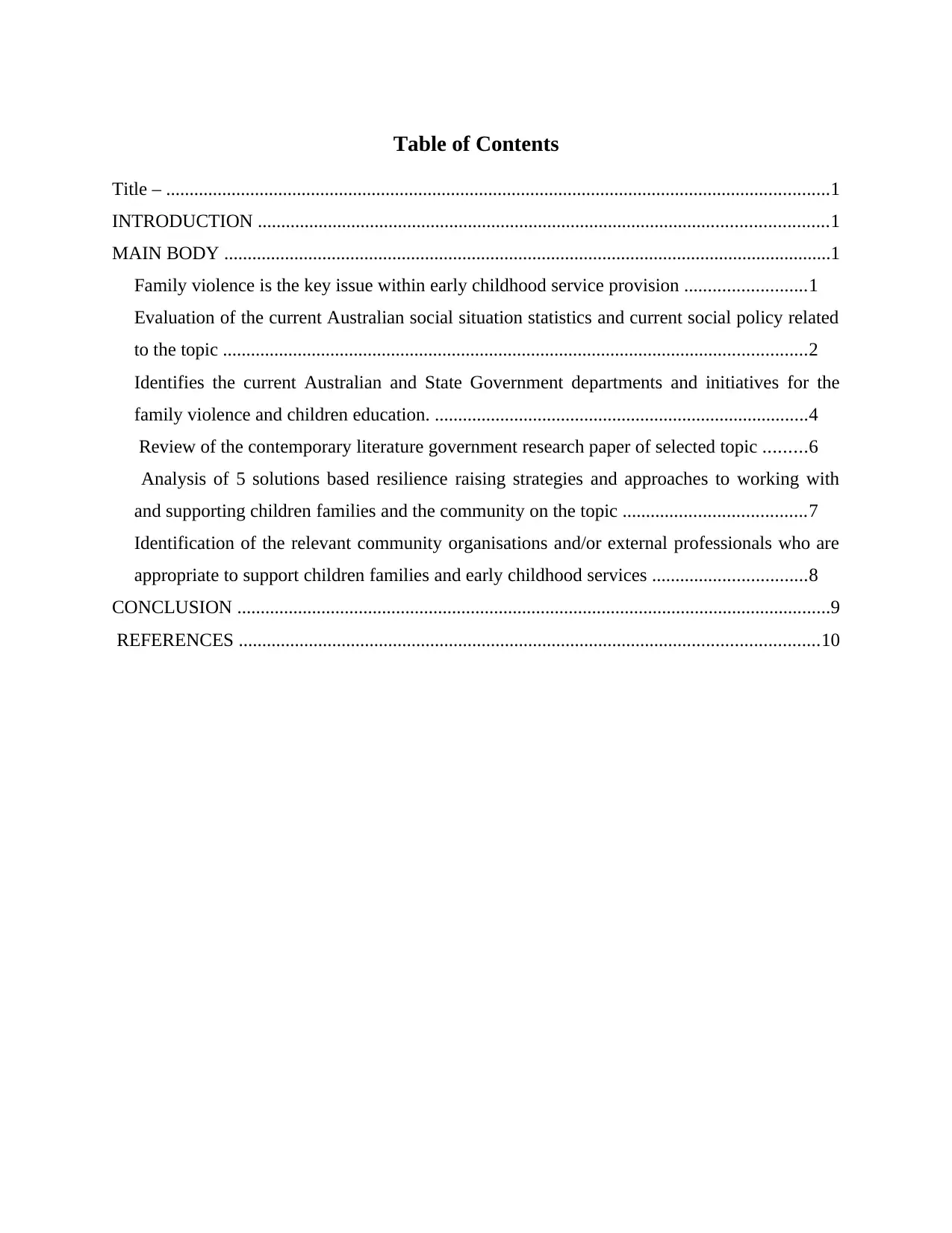
Table of Contents
Title – ..............................................................................................................................................1
INTRODUCTION ..........................................................................................................................1
MAIN BODY ..................................................................................................................................1
Family violence is the key issue within early childhood service provision ..........................1
Evaluation of the current Australian social situation statistics and current social policy related
to the topic .............................................................................................................................2
Identifies the current Australian and State Government departments and initiatives for the
family violence and children education. ................................................................................4
Review of the contemporary literature government research paper of selected topic .........6
Analysis of 5 solutions based resilience raising strategies and approaches to working with
and supporting children families and the community on the topic .......................................7
Identification of the relevant community organisations and/or external professionals who are
appropriate to support children families and early childhood services .................................8
CONCLUSION ...............................................................................................................................9
REFERENCES ............................................................................................................................10
Title – ..............................................................................................................................................1
INTRODUCTION ..........................................................................................................................1
MAIN BODY ..................................................................................................................................1
Family violence is the key issue within early childhood service provision ..........................1
Evaluation of the current Australian social situation statistics and current social policy related
to the topic .............................................................................................................................2
Identifies the current Australian and State Government departments and initiatives for the
family violence and children education. ................................................................................4
Review of the contemporary literature government research paper of selected topic .........6
Analysis of 5 solutions based resilience raising strategies and approaches to working with
and supporting children families and the community on the topic .......................................7
Identification of the relevant community organisations and/or external professionals who are
appropriate to support children families and early childhood services .................................8
CONCLUSION ...............................................................................................................................9
REFERENCES ............................................................................................................................10
⊘ This is a preview!⊘
Do you want full access?
Subscribe today to unlock all pages.

Trusted by 1+ million students worldwide
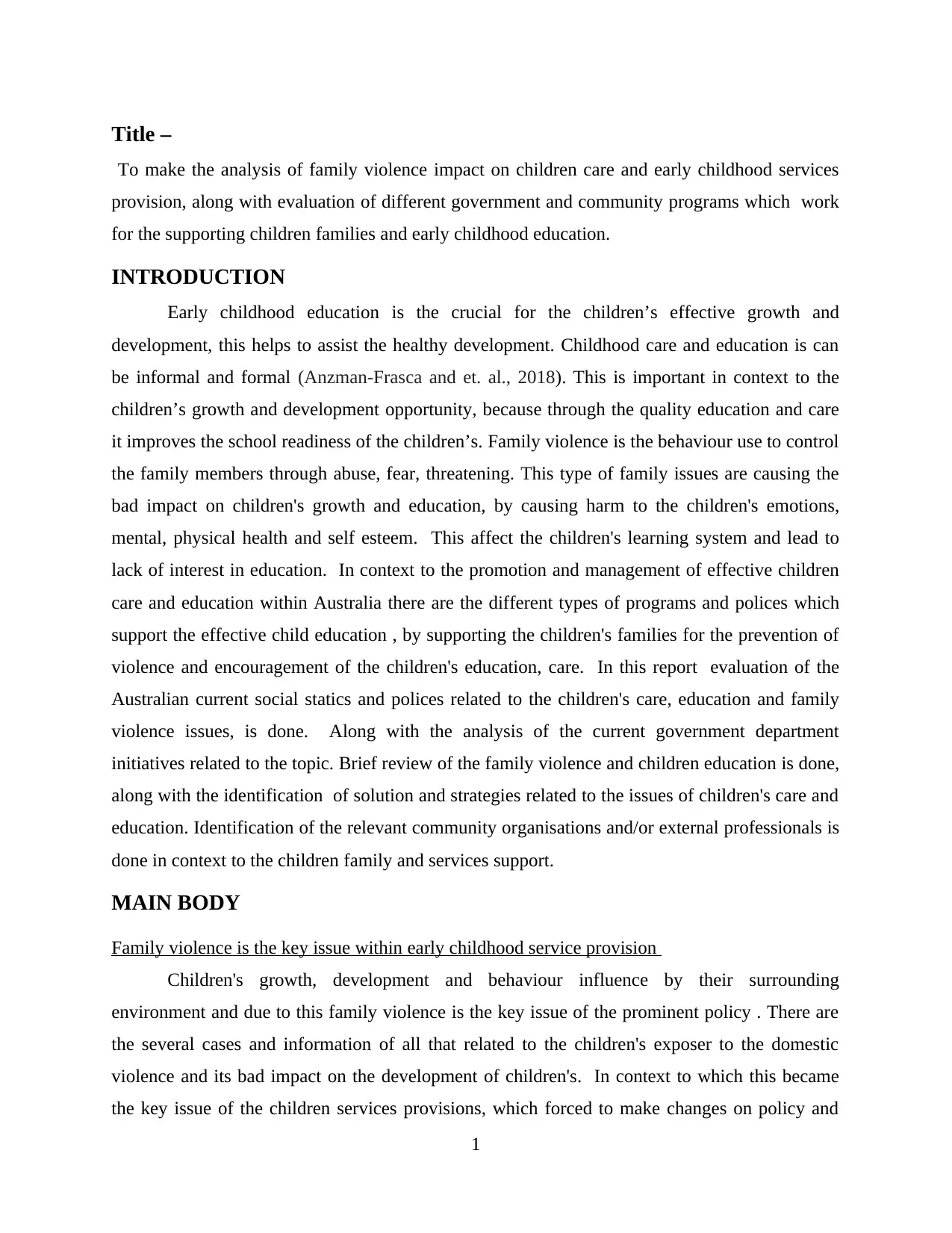
Title –
To make the analysis of family violence impact on children care and early childhood services
provision, along with evaluation of different government and community programs which work
for the supporting children families and early childhood education.
INTRODUCTION
Early childhood education is the crucial for the children’s effective growth and
development, this helps to assist the healthy development. Childhood care and education is can
be informal and formal (Anzman‐Frasca and et. al., 2018). This is important in context to the
children’s growth and development opportunity, because through the quality education and care
it improves the school readiness of the children’s. Family violence is the behaviour use to control
the family members through abuse, fear, threatening. This type of family issues are causing the
bad impact on children's growth and education, by causing harm to the children's emotions,
mental, physical health and self esteem. This affect the children's learning system and lead to
lack of interest in education. In context to the promotion and management of effective children
care and education within Australia there are the different types of programs and polices which
support the effective child education , by supporting the children's families for the prevention of
violence and encouragement of the children's education, care. In this report evaluation of the
Australian current social statics and polices related to the children's care, education and family
violence issues, is done. Along with the analysis of the current government department
initiatives related to the topic. Brief review of the family violence and children education is done,
along with the identification of solution and strategies related to the issues of children's care and
education. Identification of the relevant community organisations and/or external professionals is
done in context to the children family and services support.
MAIN BODY
Family violence is the key issue within early childhood service provision
Children's growth, development and behaviour influence by their surrounding
environment and due to this family violence is the key issue of the prominent policy . There are
the several cases and information of all that related to the children's exposer to the domestic
violence and its bad impact on the development of children's. In context to which this became
the key issue of the children services provisions, which forced to make changes on policy and
1
To make the analysis of family violence impact on children care and early childhood services
provision, along with evaluation of different government and community programs which work
for the supporting children families and early childhood education.
INTRODUCTION
Early childhood education is the crucial for the children’s effective growth and
development, this helps to assist the healthy development. Childhood care and education is can
be informal and formal (Anzman‐Frasca and et. al., 2018). This is important in context to the
children’s growth and development opportunity, because through the quality education and care
it improves the school readiness of the children’s. Family violence is the behaviour use to control
the family members through abuse, fear, threatening. This type of family issues are causing the
bad impact on children's growth and education, by causing harm to the children's emotions,
mental, physical health and self esteem. This affect the children's learning system and lead to
lack of interest in education. In context to the promotion and management of effective children
care and education within Australia there are the different types of programs and polices which
support the effective child education , by supporting the children's families for the prevention of
violence and encouragement of the children's education, care. In this report evaluation of the
Australian current social statics and polices related to the children's care, education and family
violence issues, is done. Along with the analysis of the current government department
initiatives related to the topic. Brief review of the family violence and children education is done,
along with the identification of solution and strategies related to the issues of children's care and
education. Identification of the relevant community organisations and/or external professionals is
done in context to the children family and services support.
MAIN BODY
Family violence is the key issue within early childhood service provision
Children's growth, development and behaviour influence by their surrounding
environment and due to this family violence is the key issue of the prominent policy . There are
the several cases and information of all that related to the children's exposer to the domestic
violence and its bad impact on the development of children's. In context to which this became
the key issue of the children services provisions, which forced to make changes on policy and
1
Paraphrase This Document
Need a fresh take? Get an instant paraphrase of this document with our AI Paraphraser
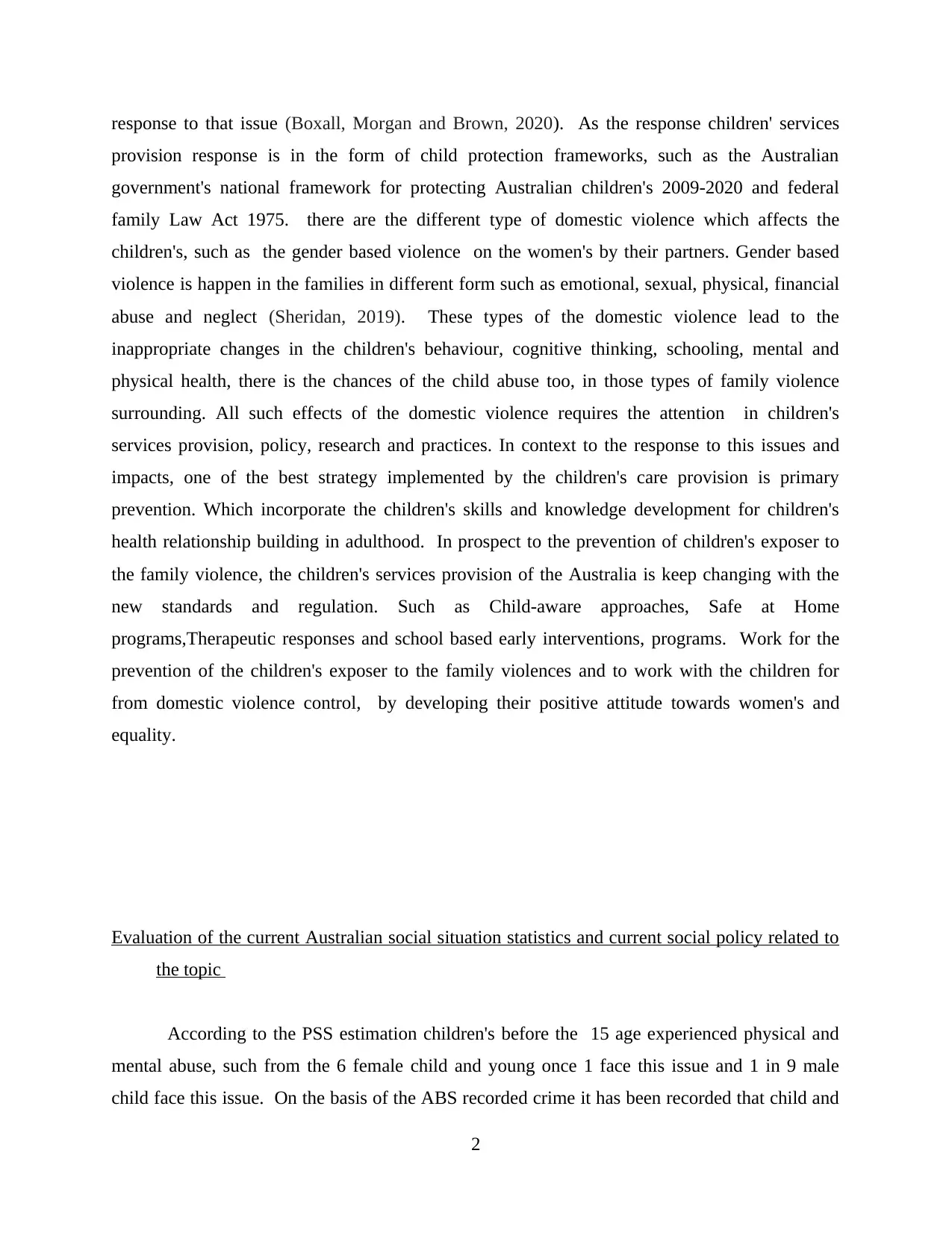
response to that issue (Boxall, Morgan and Brown, 2020). As the response children' services
provision response is in the form of child protection frameworks, such as the Australian
government's national framework for protecting Australian children's 2009-2020 and federal
family Law Act 1975. there are the different type of domestic violence which affects the
children's, such as the gender based violence on the women's by their partners. Gender based
violence is happen in the families in different form such as emotional, sexual, physical, financial
abuse and neglect (Sheridan, 2019). These types of the domestic violence lead to the
inappropriate changes in the children's behaviour, cognitive thinking, schooling, mental and
physical health, there is the chances of the child abuse too, in those types of family violence
surrounding. All such effects of the domestic violence requires the attention in children's
services provision, policy, research and practices. In context to the response to this issues and
impacts, one of the best strategy implemented by the children's care provision is primary
prevention. Which incorporate the children's skills and knowledge development for children's
health relationship building in adulthood. In prospect to the prevention of children's exposer to
the family violence, the children's services provision of the Australia is keep changing with the
new standards and regulation. Such as Child-aware approaches, Safe at Home
programs,Therapeutic responses and school based early interventions, programs. Work for the
prevention of the children's exposer to the family violences and to work with the children for
from domestic violence control, by developing their positive attitude towards women's and
equality.
Evaluation of the current Australian social situation statistics and current social policy related to
the topic
According to the PSS estimation children's before the 15 age experienced physical and
mental abuse, such from the 6 female child and young once 1 face this issue and 1 in 9 male
child face this issue. On the basis of the ABS recorded crime it has been recorded that child and
2
provision response is in the form of child protection frameworks, such as the Australian
government's national framework for protecting Australian children's 2009-2020 and federal
family Law Act 1975. there are the different type of domestic violence which affects the
children's, such as the gender based violence on the women's by their partners. Gender based
violence is happen in the families in different form such as emotional, sexual, physical, financial
abuse and neglect (Sheridan, 2019). These types of the domestic violence lead to the
inappropriate changes in the children's behaviour, cognitive thinking, schooling, mental and
physical health, there is the chances of the child abuse too, in those types of family violence
surrounding. All such effects of the domestic violence requires the attention in children's
services provision, policy, research and practices. In context to the response to this issues and
impacts, one of the best strategy implemented by the children's care provision is primary
prevention. Which incorporate the children's skills and knowledge development for children's
health relationship building in adulthood. In prospect to the prevention of children's exposer to
the family violence, the children's services provision of the Australia is keep changing with the
new standards and regulation. Such as Child-aware approaches, Safe at Home
programs,Therapeutic responses and school based early interventions, programs. Work for the
prevention of the children's exposer to the family violences and to work with the children for
from domestic violence control, by developing their positive attitude towards women's and
equality.
Evaluation of the current Australian social situation statistics and current social policy related to
the topic
According to the PSS estimation children's before the 15 age experienced physical and
mental abuse, such from the 6 female child and young once 1 face this issue and 1 in 9 male
child face this issue. On the basis of the ABS recorded crime it has been recorded that child and
2
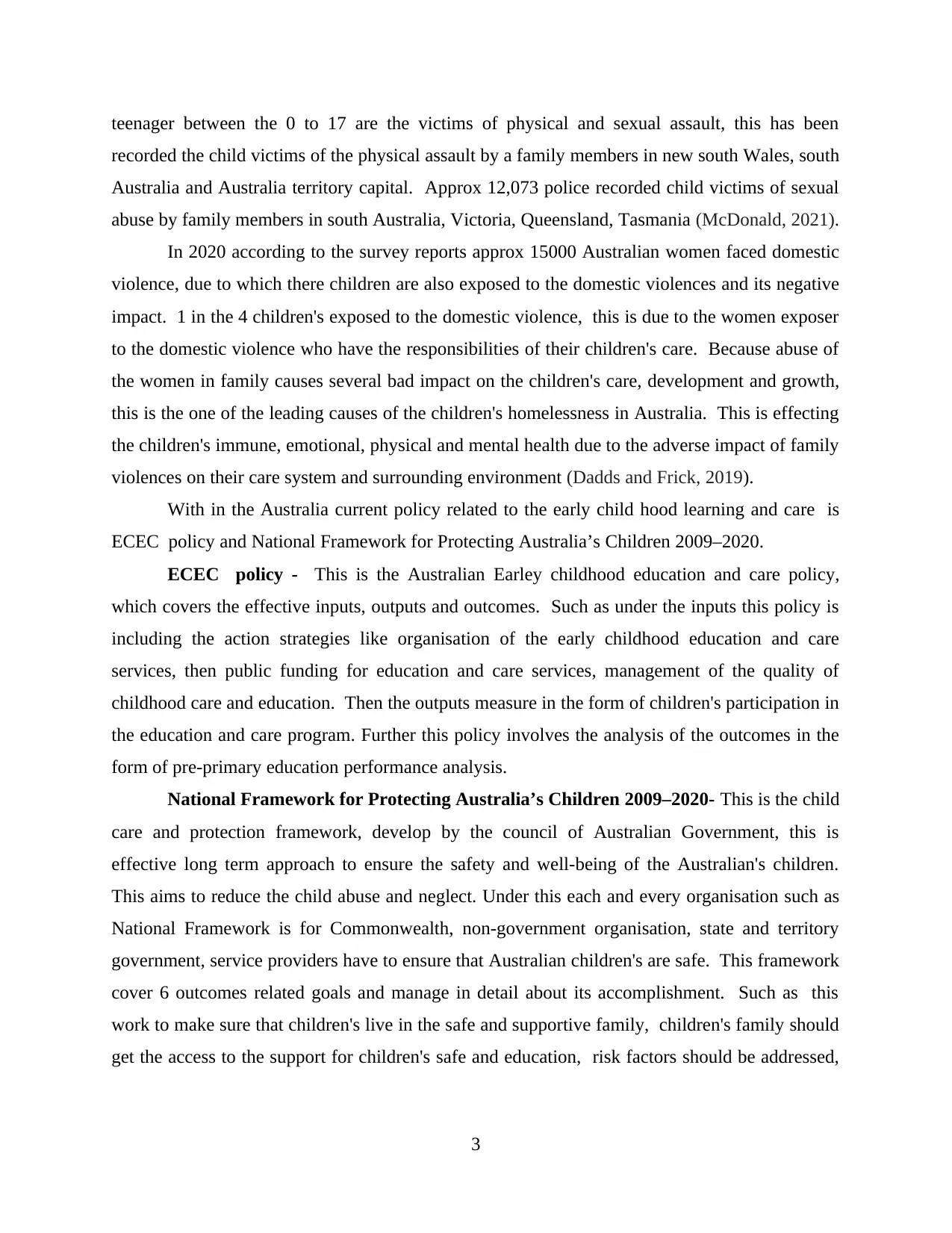
teenager between the 0 to 17 are the victims of physical and sexual assault, this has been
recorded the child victims of the physical assault by a family members in new south Wales, south
Australia and Australia territory capital. Approx 12,073 police recorded child victims of sexual
abuse by family members in south Australia, Victoria, Queensland, Tasmania (McDonald, 2021).
In 2020 according to the survey reports approx 15000 Australian women faced domestic
violence, due to which there children are also exposed to the domestic violences and its negative
impact. 1 in the 4 children's exposed to the domestic violence, this is due to the women exposer
to the domestic violence who have the responsibilities of their children's care. Because abuse of
the women in family causes several bad impact on the children's care, development and growth,
this is the one of the leading causes of the children's homelessness in Australia. This is effecting
the children's immune, emotional, physical and mental health due to the adverse impact of family
violences on their care system and surrounding environment (Dadds and Frick, 2019).
With in the Australia current policy related to the early child hood learning and care is
ECEC policy and National Framework for Protecting Australia’s Children 2009–2020.
ECEC policy - This is the Australian Earley childhood education and care policy,
which covers the effective inputs, outputs and outcomes. Such as under the inputs this policy is
including the action strategies like organisation of the early childhood education and care
services, then public funding for education and care services, management of the quality of
childhood care and education. Then the outputs measure in the form of children's participation in
the education and care program. Further this policy involves the analysis of the outcomes in the
form of pre-primary education performance analysis.
National Framework for Protecting Australia’s Children 2009–2020- This is the child
care and protection framework, develop by the council of Australian Government, this is
effective long term approach to ensure the safety and well-being of the Australian's children.
This aims to reduce the child abuse and neglect. Under this each and every organisation such as
National Framework is for Commonwealth, non-government organisation, state and territory
government, service providers have to ensure that Australian children's are safe. This framework
cover 6 outcomes related goals and manage in detail about its accomplishment. Such as this
work to make sure that children's live in the safe and supportive family, children's family should
get the access to the support for children's safe and education, risk factors should be addressed,
3
recorded the child victims of the physical assault by a family members in new south Wales, south
Australia and Australia territory capital. Approx 12,073 police recorded child victims of sexual
abuse by family members in south Australia, Victoria, Queensland, Tasmania (McDonald, 2021).
In 2020 according to the survey reports approx 15000 Australian women faced domestic
violence, due to which there children are also exposed to the domestic violences and its negative
impact. 1 in the 4 children's exposed to the domestic violence, this is due to the women exposer
to the domestic violence who have the responsibilities of their children's care. Because abuse of
the women in family causes several bad impact on the children's care, development and growth,
this is the one of the leading causes of the children's homelessness in Australia. This is effecting
the children's immune, emotional, physical and mental health due to the adverse impact of family
violences on their care system and surrounding environment (Dadds and Frick, 2019).
With in the Australia current policy related to the early child hood learning and care is
ECEC policy and National Framework for Protecting Australia’s Children 2009–2020.
ECEC policy - This is the Australian Earley childhood education and care policy,
which covers the effective inputs, outputs and outcomes. Such as under the inputs this policy is
including the action strategies like organisation of the early childhood education and care
services, then public funding for education and care services, management of the quality of
childhood care and education. Then the outputs measure in the form of children's participation in
the education and care program. Further this policy involves the analysis of the outcomes in the
form of pre-primary education performance analysis.
National Framework for Protecting Australia’s Children 2009–2020- This is the child
care and protection framework, develop by the council of Australian Government, this is
effective long term approach to ensure the safety and well-being of the Australian's children.
This aims to reduce the child abuse and neglect. Under this each and every organisation such as
National Framework is for Commonwealth, non-government organisation, state and territory
government, service providers have to ensure that Australian children's are safe. This framework
cover 6 outcomes related goals and manage in detail about its accomplishment. Such as this
work to make sure that children's live in the safe and supportive family, children's family should
get the access to the support for children's safe and education, risk factors should be addressed,
3
⊘ This is a preview!⊘
Do you want full access?
Subscribe today to unlock all pages.

Trusted by 1+ million students worldwide
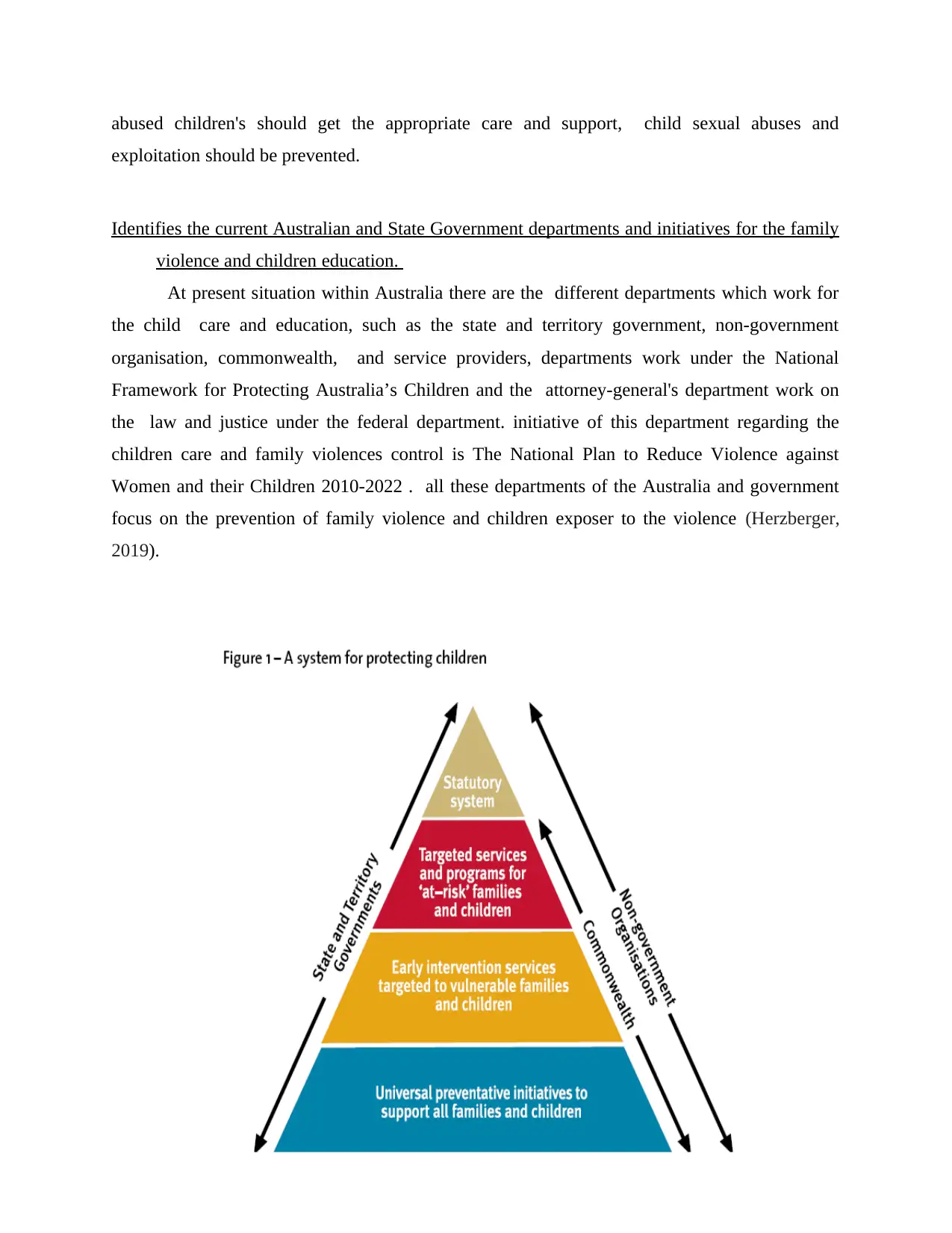
abused children's should get the appropriate care and support, child sexual abuses and
exploitation should be prevented.
Identifies the current Australian and State Government departments and initiatives for the family
violence and children education.
At present situation within Australia there are the different departments which work for
the child care and education, such as the state and territory government, non-government
organisation, commonwealth, and service providers, departments work under the National
Framework for Protecting Australia’s Children and the attorney-general's department work on
the law and justice under the federal department. initiative of this department regarding the
children care and family violences control is The National Plan to Reduce Violence against
Women and their Children 2010-2022 . all these departments of the Australia and government
focus on the prevention of family violence and children exposer to the violence (Herzberger,
2019).
4
exploitation should be prevented.
Identifies the current Australian and State Government departments and initiatives for the family
violence and children education.
At present situation within Australia there are the different departments which work for
the child care and education, such as the state and territory government, non-government
organisation, commonwealth, and service providers, departments work under the National
Framework for Protecting Australia’s Children and the attorney-general's department work on
the law and justice under the federal department. initiative of this department regarding the
children care and family violences control is The National Plan to Reduce Violence against
Women and their Children 2010-2022 . all these departments of the Australia and government
focus on the prevention of family violence and children exposer to the violence (Herzberger,
2019).
4
Paraphrase This Document
Need a fresh take? Get an instant paraphrase of this document with our AI Paraphraser
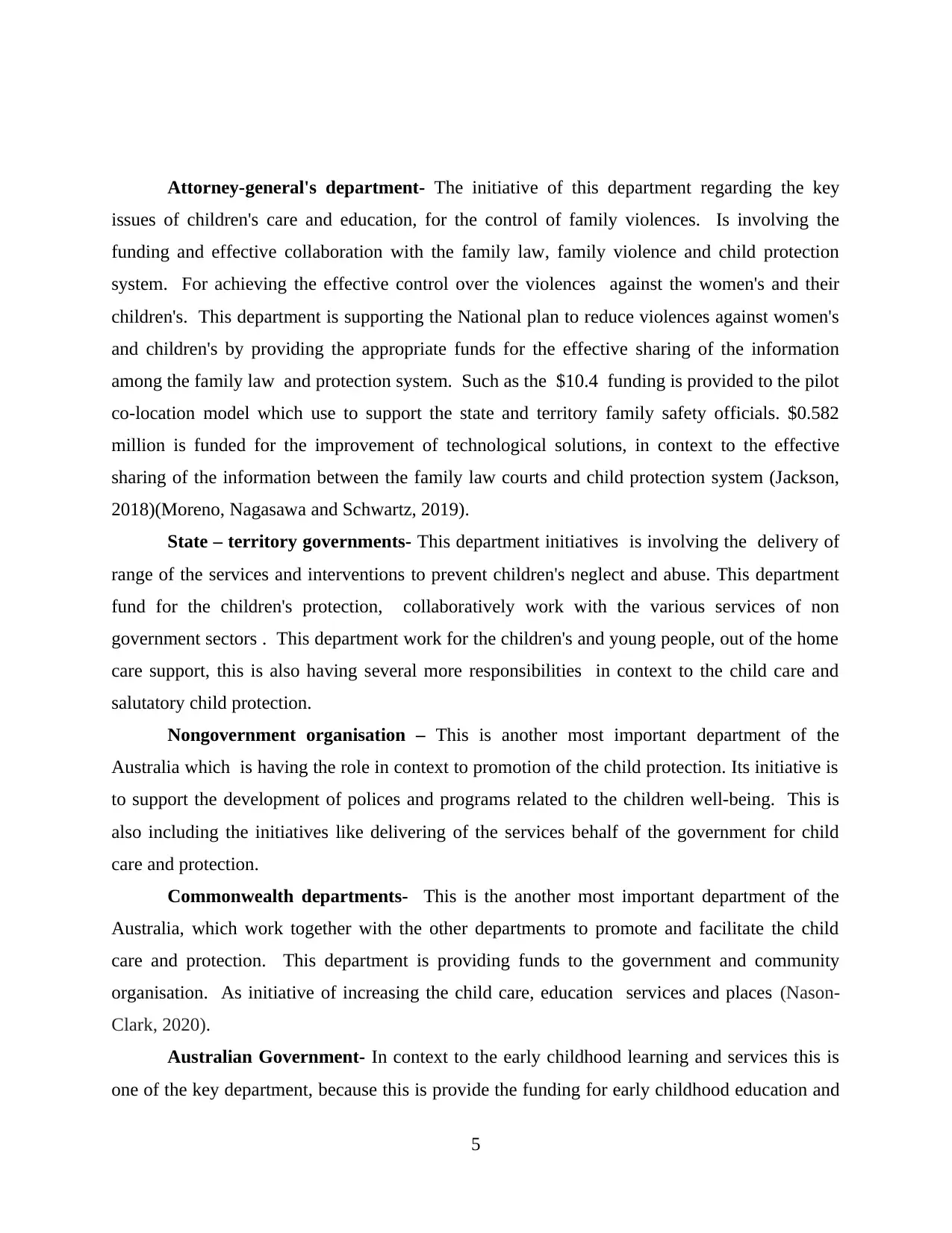
Attorney-general's department- The initiative of this department regarding the key
issues of children's care and education, for the control of family violences. Is involving the
funding and effective collaboration with the family law, family violence and child protection
system. For achieving the effective control over the violences against the women's and their
children's. This department is supporting the National plan to reduce violences against women's
and children's by providing the appropriate funds for the effective sharing of the information
among the family law and protection system. Such as the $10.4 funding is provided to the pilot
co-location model which use to support the state and territory family safety officials. $0.582
million is funded for the improvement of technological solutions, in context to the effective
sharing of the information between the family law courts and child protection system (Jackson,
2018)(Moreno, Nagasawa and Schwartz, 2019).
State – territory governments- This department initiatives is involving the delivery of
range of the services and interventions to prevent children's neglect and abuse. This department
fund for the children's protection, collaboratively work with the various services of non
government sectors . This department work for the children's and young people, out of the home
care support, this is also having several more responsibilities in context to the child care and
salutatory child protection.
Nongovernment organisation – This is another most important department of the
Australia which is having the role in context to promotion of the child protection. Its initiative is
to support the development of polices and programs related to the children well-being. This is
also including the initiatives like delivering of the services behalf of the government for child
care and protection.
Commonwealth departments- This is the another most important department of the
Australia, which work together with the other departments to promote and facilitate the child
care and protection. This department is providing funds to the government and community
organisation. As initiative of increasing the child care, education services and places (Nason-
Clark, 2020).
Australian Government- In context to the early childhood learning and services this is
one of the key department, because this is provide the funding for early childhood education and
5
issues of children's care and education, for the control of family violences. Is involving the
funding and effective collaboration with the family law, family violence and child protection
system. For achieving the effective control over the violences against the women's and their
children's. This department is supporting the National plan to reduce violences against women's
and children's by providing the appropriate funds for the effective sharing of the information
among the family law and protection system. Such as the $10.4 funding is provided to the pilot
co-location model which use to support the state and territory family safety officials. $0.582
million is funded for the improvement of technological solutions, in context to the effective
sharing of the information between the family law courts and child protection system (Jackson,
2018)(Moreno, Nagasawa and Schwartz, 2019).
State – territory governments- This department initiatives is involving the delivery of
range of the services and interventions to prevent children's neglect and abuse. This department
fund for the children's protection, collaboratively work with the various services of non
government sectors . This department work for the children's and young people, out of the home
care support, this is also having several more responsibilities in context to the child care and
salutatory child protection.
Nongovernment organisation – This is another most important department of the
Australia which is having the role in context to promotion of the child protection. Its initiative is
to support the development of polices and programs related to the children well-being. This is
also including the initiatives like delivering of the services behalf of the government for child
care and protection.
Commonwealth departments- This is the another most important department of the
Australia, which work together with the other departments to promote and facilitate the child
care and protection. This department is providing funds to the government and community
organisation. As initiative of increasing the child care, education services and places (Nason-
Clark, 2020).
Australian Government- In context to the early childhood learning and services this is
one of the key department, because this is provide the funding for early childhood education and
5
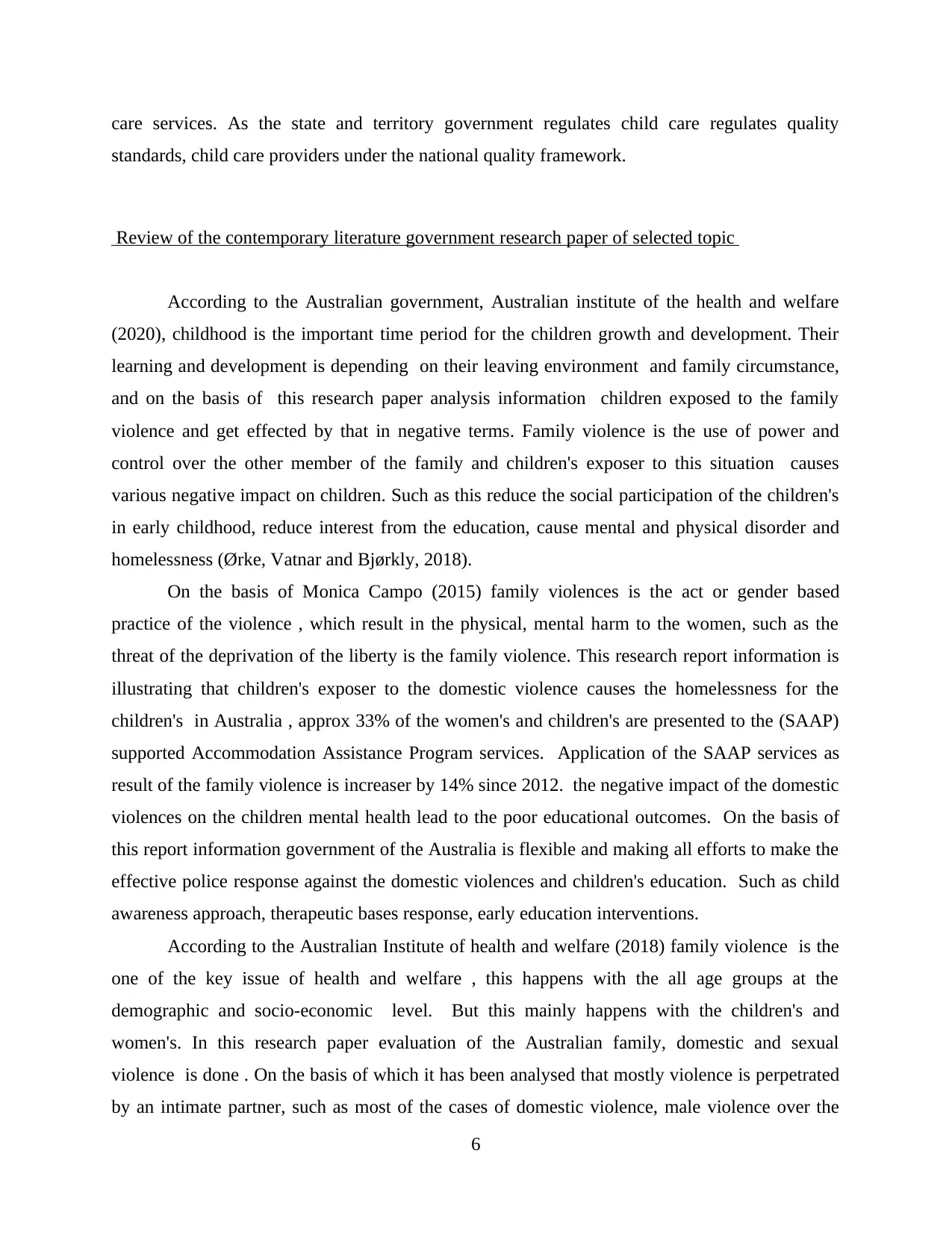
care services. As the state and territory government regulates child care regulates quality
standards, child care providers under the national quality framework.
Review of the contemporary literature government research paper of selected topic
According to the Australian government, Australian institute of the health and welfare
(2020), childhood is the important time period for the children growth and development. Their
learning and development is depending on their leaving environment and family circumstance,
and on the basis of this research paper analysis information children exposed to the family
violence and get effected by that in negative terms. Family violence is the use of power and
control over the other member of the family and children's exposer to this situation causes
various negative impact on children. Such as this reduce the social participation of the children's
in early childhood, reduce interest from the education, cause mental and physical disorder and
homelessness (Ørke, Vatnar and Bjørkly, 2018).
On the basis of Monica Campo (2015) family violences is the act or gender based
practice of the violence , which result in the physical, mental harm to the women, such as the
threat of the deprivation of the liberty is the family violence. This research report information is
illustrating that children's exposer to the domestic violence causes the homelessness for the
children's in Australia , approx 33% of the women's and children's are presented to the (SAAP)
supported Accommodation Assistance Program services. Application of the SAAP services as
result of the family violence is increaser by 14% since 2012. the negative impact of the domestic
violences on the children mental health lead to the poor educational outcomes. On the basis of
this report information government of the Australia is flexible and making all efforts to make the
effective police response against the domestic violences and children's education. Such as child
awareness approach, therapeutic bases response, early education interventions.
According to the Australian Institute of health and welfare (2018) family violence is the
one of the key issue of health and welfare , this happens with the all age groups at the
demographic and socio-economic level. But this mainly happens with the children's and
women's. In this research paper evaluation of the Australian family, domestic and sexual
violence is done . On the basis of which it has been analysed that mostly violence is perpetrated
by an intimate partner, such as most of the cases of domestic violence, male violence over the
6
standards, child care providers under the national quality framework.
Review of the contemporary literature government research paper of selected topic
According to the Australian government, Australian institute of the health and welfare
(2020), childhood is the important time period for the children growth and development. Their
learning and development is depending on their leaving environment and family circumstance,
and on the basis of this research paper analysis information children exposed to the family
violence and get effected by that in negative terms. Family violence is the use of power and
control over the other member of the family and children's exposer to this situation causes
various negative impact on children. Such as this reduce the social participation of the children's
in early childhood, reduce interest from the education, cause mental and physical disorder and
homelessness (Ørke, Vatnar and Bjørkly, 2018).
On the basis of Monica Campo (2015) family violences is the act or gender based
practice of the violence , which result in the physical, mental harm to the women, such as the
threat of the deprivation of the liberty is the family violence. This research report information is
illustrating that children's exposer to the domestic violence causes the homelessness for the
children's in Australia , approx 33% of the women's and children's are presented to the (SAAP)
supported Accommodation Assistance Program services. Application of the SAAP services as
result of the family violence is increaser by 14% since 2012. the negative impact of the domestic
violences on the children mental health lead to the poor educational outcomes. On the basis of
this report information government of the Australia is flexible and making all efforts to make the
effective police response against the domestic violences and children's education. Such as child
awareness approach, therapeutic bases response, early education interventions.
According to the Australian Institute of health and welfare (2018) family violence is the
one of the key issue of health and welfare , this happens with the all age groups at the
demographic and socio-economic level. But this mainly happens with the children's and
women's. In this research paper evaluation of the Australian family, domestic and sexual
violence is done . On the basis of which it has been analysed that mostly violence is perpetrated
by an intimate partner, such as most of the cases of domestic violence, male violence over the
6
⊘ This is a preview!⊘
Do you want full access?
Subscribe today to unlock all pages.

Trusted by 1+ million students worldwide
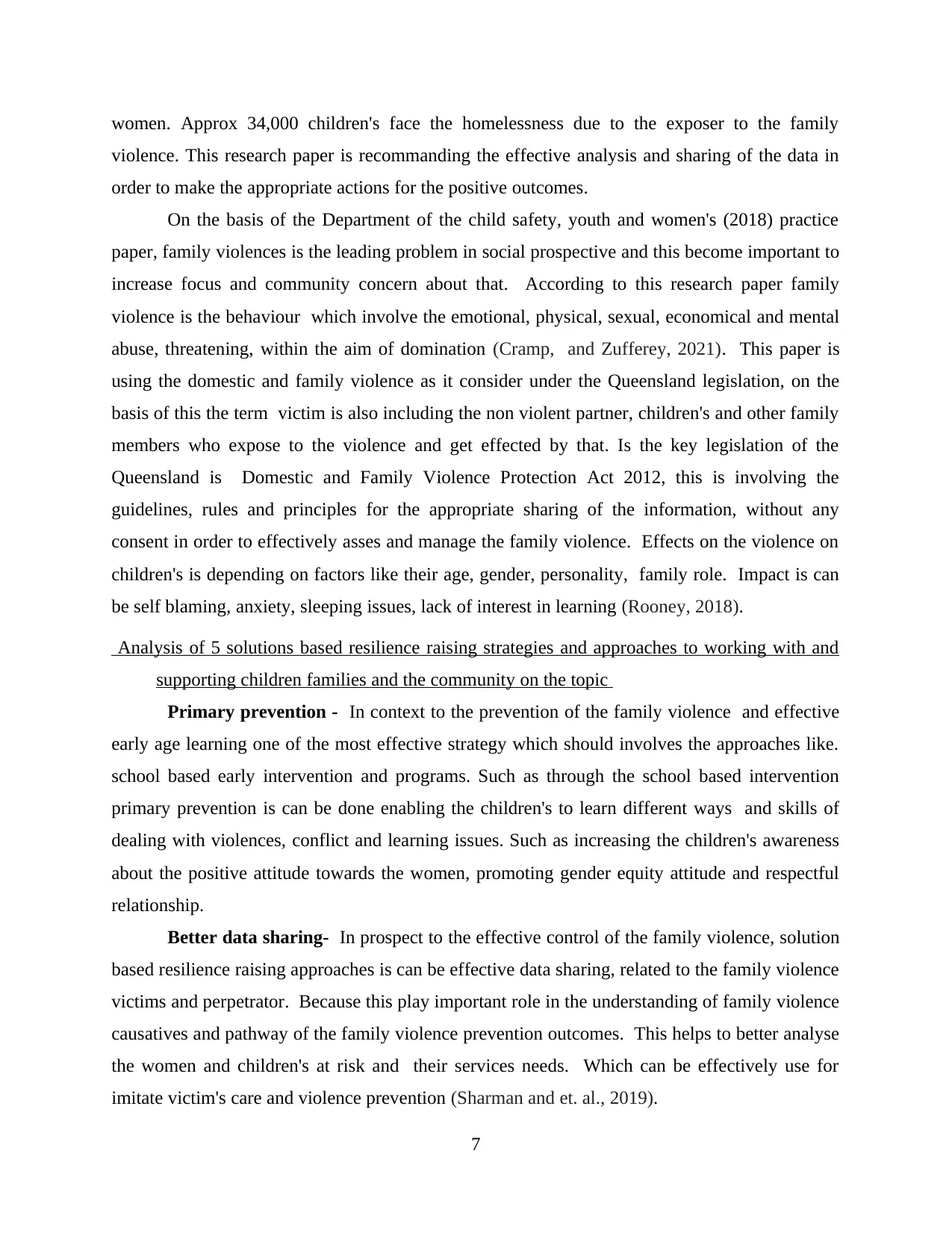
women. Approx 34,000 children's face the homelessness due to the exposer to the family
violence. This research paper is recommanding the effective analysis and sharing of the data in
order to make the appropriate actions for the positive outcomes.
On the basis of the Department of the child safety, youth and women's (2018) practice
paper, family violences is the leading problem in social prospective and this become important to
increase focus and community concern about that. According to this research paper family
violence is the behaviour which involve the emotional, physical, sexual, economical and mental
abuse, threatening, within the aim of domination (Cramp, and Zufferey, 2021). This paper is
using the domestic and family violence as it consider under the Queensland legislation, on the
basis of this the term victim is also including the non violent partner, children's and other family
members who expose to the violence and get effected by that. Is the key legislation of the
Queensland is Domestic and Family Violence Protection Act 2012, this is involving the
guidelines, rules and principles for the appropriate sharing of the information, without any
consent in order to effectively asses and manage the family violence. Effects on the violence on
children's is depending on factors like their age, gender, personality, family role. Impact is can
be self blaming, anxiety, sleeping issues, lack of interest in learning (Rooney, 2018).
Analysis of 5 solutions based resilience raising strategies and approaches to working with and
supporting children families and the community on the topic
Primary prevention - In context to the prevention of the family violence and effective
early age learning one of the most effective strategy which should involves the approaches like.
school based early intervention and programs. Such as through the school based intervention
primary prevention is can be done enabling the children's to learn different ways and skills of
dealing with violences, conflict and learning issues. Such as increasing the children's awareness
about the positive attitude towards the women, promoting gender equity attitude and respectful
relationship.
Better data sharing- In prospect to the effective control of the family violence, solution
based resilience raising approaches is can be effective data sharing, related to the family violence
victims and perpetrator. Because this play important role in the understanding of family violence
causatives and pathway of the family violence prevention outcomes. This helps to better analyse
the women and children's at risk and their services needs. Which can be effectively use for
imitate victim's care and violence prevention (Sharman and et. al., 2019).
7
violence. This research paper is recommanding the effective analysis and sharing of the data in
order to make the appropriate actions for the positive outcomes.
On the basis of the Department of the child safety, youth and women's (2018) practice
paper, family violences is the leading problem in social prospective and this become important to
increase focus and community concern about that. According to this research paper family
violence is the behaviour which involve the emotional, physical, sexual, economical and mental
abuse, threatening, within the aim of domination (Cramp, and Zufferey, 2021). This paper is
using the domestic and family violence as it consider under the Queensland legislation, on the
basis of this the term victim is also including the non violent partner, children's and other family
members who expose to the violence and get effected by that. Is the key legislation of the
Queensland is Domestic and Family Violence Protection Act 2012, this is involving the
guidelines, rules and principles for the appropriate sharing of the information, without any
consent in order to effectively asses and manage the family violence. Effects on the violence on
children's is depending on factors like their age, gender, personality, family role. Impact is can
be self blaming, anxiety, sleeping issues, lack of interest in learning (Rooney, 2018).
Analysis of 5 solutions based resilience raising strategies and approaches to working with and
supporting children families and the community on the topic
Primary prevention - In context to the prevention of the family violence and effective
early age learning one of the most effective strategy which should involves the approaches like.
school based early intervention and programs. Such as through the school based intervention
primary prevention is can be done enabling the children's to learn different ways and skills of
dealing with violences, conflict and learning issues. Such as increasing the children's awareness
about the positive attitude towards the women, promoting gender equity attitude and respectful
relationship.
Better data sharing- In prospect to the effective control of the family violence, solution
based resilience raising approaches is can be effective data sharing, related to the family violence
victims and perpetrator. Because this play important role in the understanding of family violence
causatives and pathway of the family violence prevention outcomes. This helps to better analyse
the women and children's at risk and their services needs. Which can be effectively use for
imitate victim's care and violence prevention (Sharman and et. al., 2019).
7
Paraphrase This Document
Need a fresh take? Get an instant paraphrase of this document with our AI Paraphraser
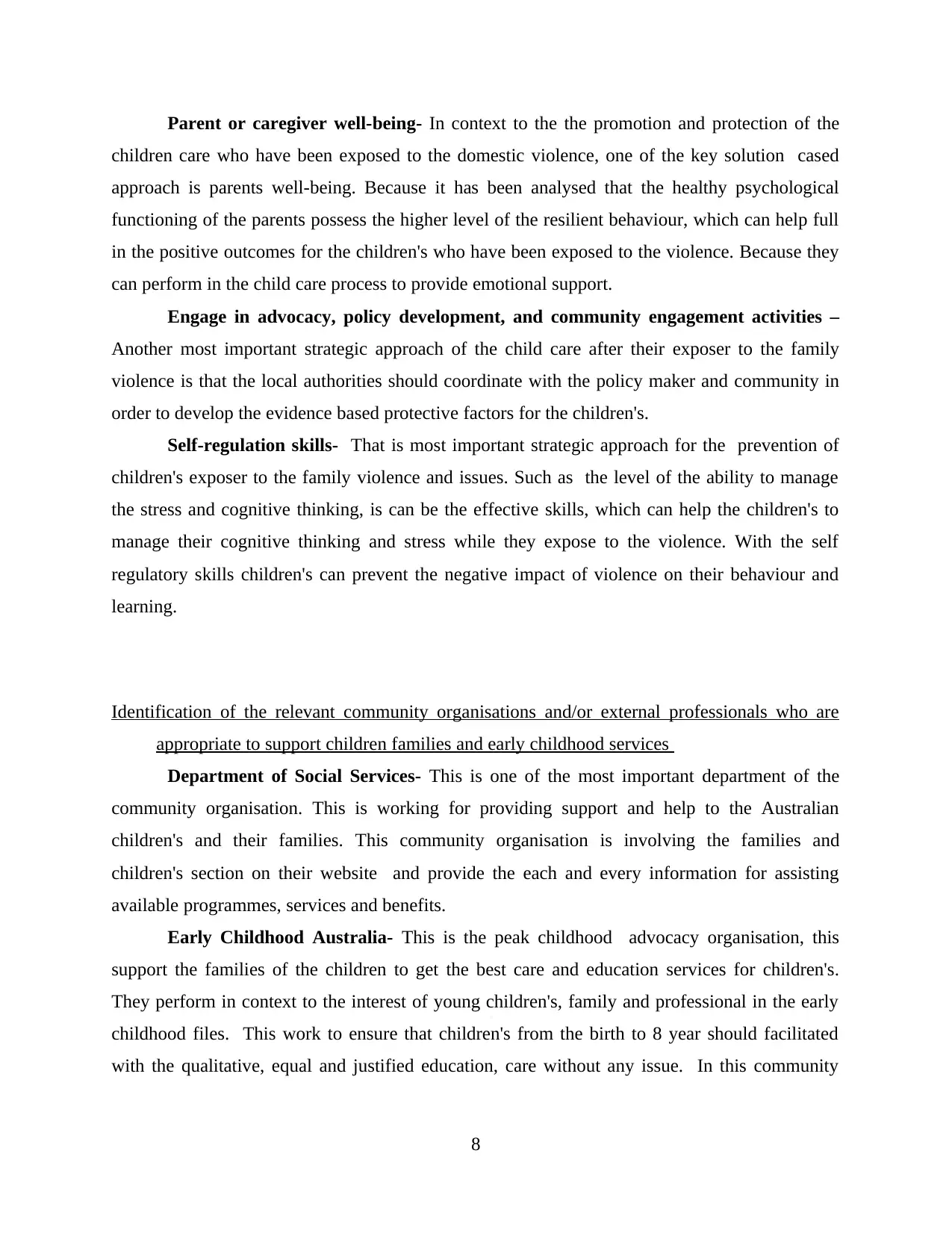
Parent or caregiver well-being- In context to the the promotion and protection of the
children care who have been exposed to the domestic violence, one of the key solution cased
approach is parents well-being. Because it has been analysed that the healthy psychological
functioning of the parents possess the higher level of the resilient behaviour, which can help full
in the positive outcomes for the children's who have been exposed to the violence. Because they
can perform in the child care process to provide emotional support.
Engage in advocacy, policy development, and community engagement activities –
Another most important strategic approach of the child care after their exposer to the family
violence is that the local authorities should coordinate with the policy maker and community in
order to develop the evidence based protective factors for the children's.
Self-regulation skills- That is most important strategic approach for the prevention of
children's exposer to the family violence and issues. Such as the level of the ability to manage
the stress and cognitive thinking, is can be the effective skills, which can help the children's to
manage their cognitive thinking and stress while they expose to the violence. With the self
regulatory skills children's can prevent the negative impact of violence on their behaviour and
learning.
Identification of the relevant community organisations and/or external professionals who are
appropriate to support children families and early childhood services
Department of Social Services- This is one of the most important department of the
community organisation. This is working for providing support and help to the Australian
children's and their families. This community organisation is involving the families and
children's section on their website and provide the each and every information for assisting
available programmes, services and benefits.
Early Childhood Australia- This is the peak childhood advocacy organisation, this
support the families of the children to get the best care and education services for children's.
They perform in context to the interest of young children's, family and professional in the early
childhood files. This work to ensure that children's from the birth to 8 year should facilitated
with the qualitative, equal and justified education, care without any issue. In this community
8
children care who have been exposed to the domestic violence, one of the key solution cased
approach is parents well-being. Because it has been analysed that the healthy psychological
functioning of the parents possess the higher level of the resilient behaviour, which can help full
in the positive outcomes for the children's who have been exposed to the violence. Because they
can perform in the child care process to provide emotional support.
Engage in advocacy, policy development, and community engagement activities –
Another most important strategic approach of the child care after their exposer to the family
violence is that the local authorities should coordinate with the policy maker and community in
order to develop the evidence based protective factors for the children's.
Self-regulation skills- That is most important strategic approach for the prevention of
children's exposer to the family violence and issues. Such as the level of the ability to manage
the stress and cognitive thinking, is can be the effective skills, which can help the children's to
manage their cognitive thinking and stress while they expose to the violence. With the self
regulatory skills children's can prevent the negative impact of violence on their behaviour and
learning.
Identification of the relevant community organisations and/or external professionals who are
appropriate to support children families and early childhood services
Department of Social Services- This is one of the most important department of the
community organisation. This is working for providing support and help to the Australian
children's and their families. This community organisation is involving the families and
children's section on their website and provide the each and every information for assisting
available programmes, services and benefits.
Early Childhood Australia- This is the peak childhood advocacy organisation, this
support the families of the children to get the best care and education services for children's.
They perform in context to the interest of young children's, family and professional in the early
childhood files. This work to ensure that children's from the birth to 8 year should facilitated
with the qualitative, equal and justified education, care without any issue. In this community
8
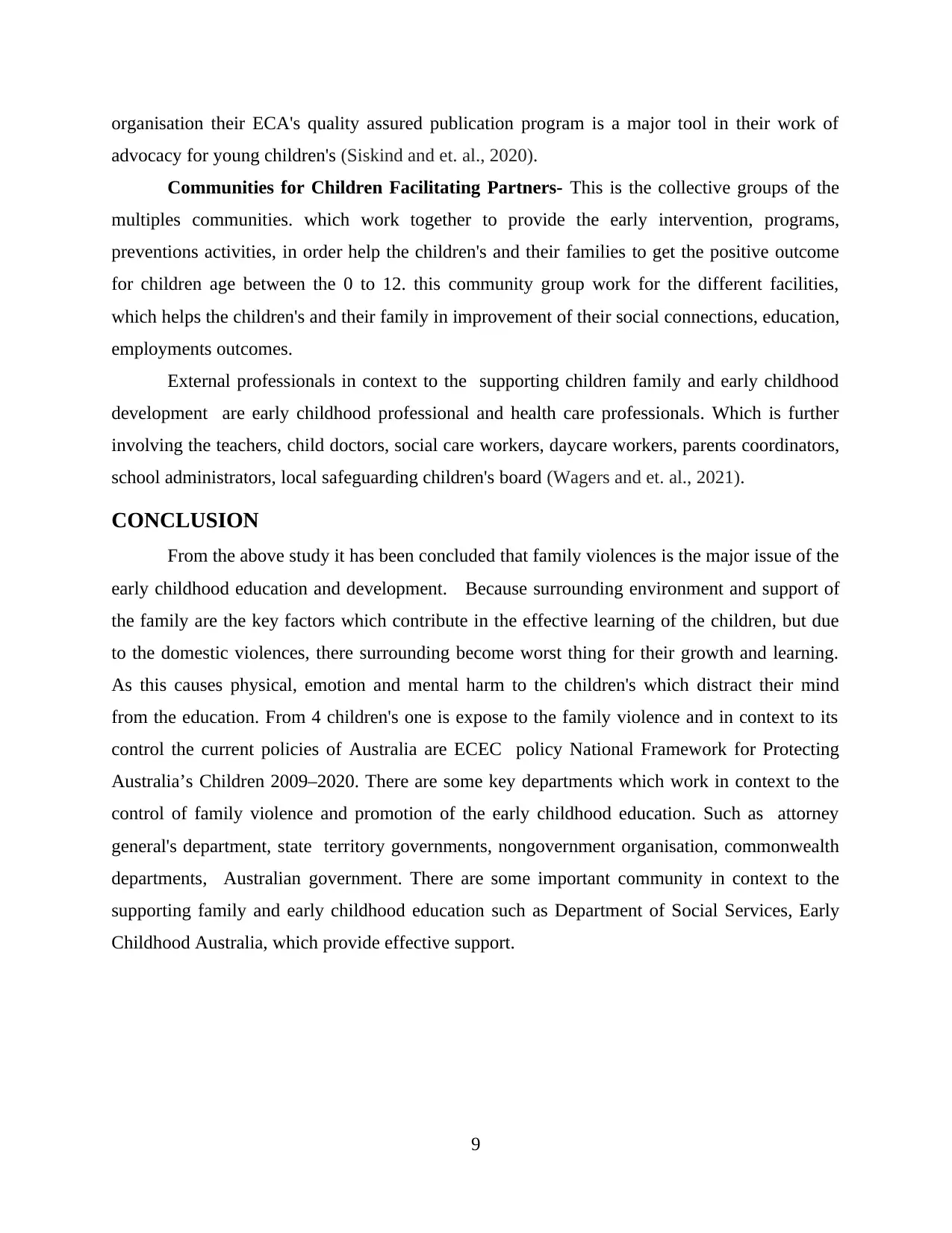
organisation their ECA's quality assured publication program is a major tool in their work of
advocacy for young children's (Siskind and et. al., 2020).
Communities for Children Facilitating Partners- This is the collective groups of the
multiples communities. which work together to provide the early intervention, programs,
preventions activities, in order help the children's and their families to get the positive outcome
for children age between the 0 to 12. this community group work for the different facilities,
which helps the children's and their family in improvement of their social connections, education,
employments outcomes.
External professionals in context to the supporting children family and early childhood
development are early childhood professional and health care professionals. Which is further
involving the teachers, child doctors, social care workers, daycare workers, parents coordinators,
school administrators, local safeguarding children's board (Wagers and et. al., 2021).
CONCLUSION
From the above study it has been concluded that family violences is the major issue of the
early childhood education and development. Because surrounding environment and support of
the family are the key factors which contribute in the effective learning of the children, but due
to the domestic violences, there surrounding become worst thing for their growth and learning.
As this causes physical, emotion and mental harm to the children's which distract their mind
from the education. From 4 children's one is expose to the family violence and in context to its
control the current policies of Australia are ECEC policy National Framework for Protecting
Australia’s Children 2009–2020. There are some key departments which work in context to the
control of family violence and promotion of the early childhood education. Such as attorney
general's department, state territory governments, nongovernment organisation, commonwealth
departments, Australian government. There are some important community in context to the
supporting family and early childhood education such as Department of Social Services, Early
Childhood Australia, which provide effective support.
9
advocacy for young children's (Siskind and et. al., 2020).
Communities for Children Facilitating Partners- This is the collective groups of the
multiples communities. which work together to provide the early intervention, programs,
preventions activities, in order help the children's and their families to get the positive outcome
for children age between the 0 to 12. this community group work for the different facilities,
which helps the children's and their family in improvement of their social connections, education,
employments outcomes.
External professionals in context to the supporting children family and early childhood
development are early childhood professional and health care professionals. Which is further
involving the teachers, child doctors, social care workers, daycare workers, parents coordinators,
school administrators, local safeguarding children's board (Wagers and et. al., 2021).
CONCLUSION
From the above study it has been concluded that family violences is the major issue of the
early childhood education and development. Because surrounding environment and support of
the family are the key factors which contribute in the effective learning of the children, but due
to the domestic violences, there surrounding become worst thing for their growth and learning.
As this causes physical, emotion and mental harm to the children's which distract their mind
from the education. From 4 children's one is expose to the family violence and in context to its
control the current policies of Australia are ECEC policy National Framework for Protecting
Australia’s Children 2009–2020. There are some key departments which work in context to the
control of family violence and promotion of the early childhood education. Such as attorney
general's department, state territory governments, nongovernment organisation, commonwealth
departments, Australian government. There are some important community in context to the
supporting family and early childhood education such as Department of Social Services, Early
Childhood Australia, which provide effective support.
9
⊘ This is a preview!⊘
Do you want full access?
Subscribe today to unlock all pages.

Trusted by 1+ million students worldwide
1 out of 15
Related Documents
Your All-in-One AI-Powered Toolkit for Academic Success.
+13062052269
info@desklib.com
Available 24*7 on WhatsApp / Email
![[object Object]](/_next/static/media/star-bottom.7253800d.svg)
Unlock your academic potential
Copyright © 2020–2025 A2Z Services. All Rights Reserved. Developed and managed by ZUCOL.





